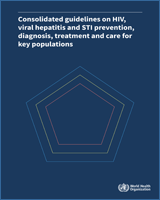Background
Sex workers include female, male, trans and gender diverse adults (18 years of age and above) who receive money or goods in exchange for sexual services, either regularly or occasionally. Sex work is consensual sex between adults, can take many forms, and varies between and within countries and communities. Sex work also varies in the degree to which it is more or less “formal”, or organized (3, 84). Increasingly, sex workers are meeting and staying in contact with their clients online.
As defined in the Convention on the Rights of the Child (CRC), children and adolescents under the age of 18 who exchange sex for money, goods or favours are “sexually exploited” and not defined as sex workers (203, 204). (Please see Chapter 7 on young key populations.)
Sex workers in many places are highly vulnerable to HIV and STIs due to multiple factors, including large numbers of sex partners, unsafe working conditions, barriers to the negotiation of consistent condom use, and intersecting social determinants of poor health. These include lack of social protection and housing, food insecurity, reduced education opportunities and disability. Moreover, sex workers often have reduced control over these factors due to structural barriers that increase their risk of unprotected sex and reduce access to health services (please see the chapter on critical enablers). In particular, sex workers may be harassed by law enforcement officers, including the practice of officers confiscating and using condoms and mobile phones as evidence of sex work; be subjected to violence from law enforcement officers, clients and intimate partners; and experience stigma and discrimination in health and other settings. As a result, sex workers are disproportionately affected by HIV and STIs. For the most recent data related to HIV, syphilis and sex workers, please access UNAIDS Key Populations Atlas.
The recommended package of interventions for sex workers includes enabling interventions that should be implemented as a priority, including the decriminalization of sex work (namely, removing all offences that criminalize sex workers, clients and third parties). Addressing these barriers would not only ensure sex workers’ human rights, but also have an impact on HIV, STIs and viral hepatitis in all settings where sex work is criminalized and sex workers experience stigma, discrimination and violence (68, 75). Other essential interventions are health interventions related to HIV and STI prevention, testing and treatment.
The majority of participants in the key populations values and preferences qualitative research (for the detailed report, please see Web Annex B) were opposed to the periodic presumptive treatment (PPT) of STIs, citing both health and ethical concerns. Participants noted an array of potential health risks associated with prolonged antibiotic use, including antibiotic resistance, kidney damage, depression and impacts on vaginal health. Additionally, participants expressed concerns surrounding the ethical implications of PPT and its role in perpetuating stigma and vulnerability. Others attested to the role of PPT in reinforcing stereotypes of sex workers as vectors of disease. Rather than offering sex workers PPT for STIs, participants stressed the need for increased access to STI testing and evidence-based prevention methods. For these reasons, the recommendation to provide PPT for STIs for sex workers is not included in these guidelines. If sex workers wish to prevent STI acquisition through PPT, this should always be voluntary, in full understanding of the potential complications, only in settings where aetiological diagnosis is not possible, and in consultation with health care providers.
WHO recommends expanding access to aetiological diagnosis of STIs for sex workers as a priority, as well as suggesting offering periodic screening for asymptomatic STIs to sex workers. Offering voluntary periodic screening for HIV and the other main curable STIs, such as syphilis, gonorrhoea and clamydia, is particularly relevant for sex workers, due to the severe consequences of STIs, including infertility. In cases of pregnancy, untreated STIs can also lead to severe adverse pregnancy outcomes, such as prematurity, neonatal death, low-birth weight and congenital anomalies. WHO has specific recommendations for the treatment of the main STIs, suppressive therapy for genital herpes, and for the management of syndromes when the aetiology cannot be investigated for the most appropriate treatment (183).
While evidence of increased prevalence of HCV and HBV in men who have sex with men is clear (12), concerns about viral hepatitis in female and trans and gender diverse sex workers are new and emerging, and there is little data available to understand global prevalence of HBV and HCV among these populations. For female and trans and gender diverse sex workers who are living with HIV, there may be an increased risk of HCV and HBV (205), although evidence is scarce, and additional small studies have shown increased risk for mono-infections (18). However, HCV prevalence is high in people who inject drugs (206) and in people in prisons (207), and there is considerable intersection between female and trans and gender diverse sex workers and these other key populations, indicating a need to ensure access to viral hepatitis prevention, testing and treatment for these groups. For this reason, viral hepatitis prevention, testing and treatment are included in the package of essential health interventions for all sex workers.
Other health issues are of particular concern to sex workers, including: those related to sexual and reproductive health (safe abortion, contraception, conception and antenatal care); those related to cervical and anal cancer prevention; and those related to screening and treatment for mental health issues, and for hazardous or harmful alcohol and substance use. In particular, the results of qualitative research undertaken by four global networks of key populations showed that addressing mental health was a priority for key populations. While global data on TB among sex workers is not available, sex workers who live and work in cramped conditions may be at increased risk of TB. These are essential interventions to address broader health beyond HIV, STIs and viral hepatitis, and access for key populations should be ensured.
The package of essential interventions for sex workers does not include those that are specifically related to HIV and viral hepatitis prevention for people who inject drugs (namely, NSPs, OAMT and naloxone for overdose management), or to gender-affirming care for trans and gender diverse people. However, for sex workers who inject drugs or who are trans and gender diverse, these are relevant interventions that should be made available, as outlined in the specific packages for these key populations.
Recommended package for sex workers
These interventions are not in order of priority.
View in own window
| Essential for impact: enabling interventions |
|---|
|
Removing punitive laws, policies and practices
Reducing stigma and discrimination
Community empowerment
Addressing violence
|
| Essential for impact: health interventions |
|---|
| Prevention of HIV, viral hepatitis and STIs |
|---|
|
Condoms and lubricant
Pre-exposure prophylaxis for HIV
Post-exposure prophylaxis for HIV and STIs
Prevention of vertical transmission of HIV, syphilis and HBV
Hepatitis B vaccination
Addressing chemsex
|
| Diagnosis |
|---|
|
HIV testing
STI testing
Hepatitis B and C testing
|
| Treatment |
|---|
|
HIV treatment
Screening, diagnosis, treatment and prevention of HIV associated TB
STI treatment
HBV and HCV treatment
|
| Essential for broader health: health interventions |
|---|
|
Anal health
Conception and pregnancy care
Contraception
Mental health
Prevention, assessment and treatment of cervical cancer
Safe abortion
Screening and treatment for hazardous and harmful alcohol and other substance use
|


